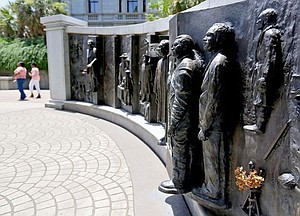1/17/2018

by Adam Parker via postandcourier.com
Many — perhaps most — African Americans can trace family roots back to Charleston. About 40 percent of enslaved Africans brought to North America arrived on ships that docked in Charleston Harbor.
Slaves then were sold to plantation owners throughout the Antebellum South. During the “Great Migration,” about 6 million blacks moved from the South to the Northeast, Midwest and West between 1916 and 1970, chastened by the ghosts of their oppressed ancestors and motivated by the prospect of a better life.
On the cusp of the Civil War, the U.S. was home to 4 million slaves, 400,000 of whom lived in South Carolina. Their labor created enormous wealth for white rice and cotton planters, and it built whole cities, including Charleston.
Now, 50 years since the death of Martin Luther King Jr., the South Carolina African American Heritage Commission has named 10 top black history sites to visit in the state, including several associated with King and the civil rights movement. The commission also has compiled a much larger list of about 300 sites for its new online travel guide, Green Book of South Carolina (www.GreenBookofSC.com).
Dawn Dawson-House, an ex officio board member who works for the S.C. Department of Parks, Recreation and Tourism, said the initiative is meant to raise awareness of black history and to assist the commission’s efforts to identify, preserve, mark and protect the state’s many sites connected to black history and heritage.
Black history sites abundant in Charleston
“In the past 24 years, more than 200 markers have been added to the official state markers program,” Dawson-House said. “When the commission started, there were only about 35 markers dedicated to black history.”
She said historical sites can be found throughout the state, and many local people know about the ones near them.
“No matter where you are in South Carolina, there is an important African-American heritage element or place to visit,” Dawson-House said. “But the entire story is not told collectively. It’s told in bits and pieces in everybody’s community. At the commission we’ve decided we have to pull together an entire portrait of this history.”
Michael Allen, a founding board member of the commission, said the Green Book — “a manifestation of out 24-year journey” meant to assist anyone interested in black history — is a reference to the Jim Crow-era guide that African Americans used when traveling through the South. The old guide provided information about black-owned businesses (gas stations, hotels, restaurants, hospitals) that were safe for black travelers during the period of legal segregation.
“When you went traveling some place, you cooked your food, packed your food, the food was in your car,” Allen said. “You planned visits according to where relatives lived, or drove straight to where you needed to be.”
The modern iteration of the Green Book, instead, is meant for everybody, Allen said. “We think this is a great opportunity to connect the community, the history, the legacy and the African American experience of South Carolinians and the traveling public,” he said. Continue reading “African American Heritage Commission of South Carolina Launches New ‘Green Book,’ Names State’s Top Black History Sites” →
